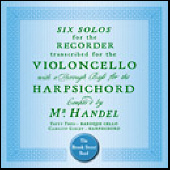

 |
 |
|
Handel Six ‘Cello Sonatas  Op 1 Nos 2, 4, 7, 9, 11; HWV377 (transcribed from recorder sonatas by Carolyn Gilbey)
The Brook Street Band Avie AV2118
Baroque composers freely transcribed works between instruments. No apology is needed for a disc such as this, though Tatty Theo (the ‘cellist) contributes a lightly-written justification. Today, the practice has again become fashionable, in particular retrospectively to augment the Baroque repertoire (such as on the recent Naxos Brandenburg concertos, where the fill-up is a ‘new' flute concerto), but also as a luxury for artists who have made a reputation playing their solo instrument and are able to import favourite pieces written for other instruments (James Galway with the Franck violin sonata and Alison Balsom are obvious examples.)
These ‘new' ‘cello sonatas will not fail to please fans of either Handel or the Brook Street Band (here cut down to Theo and Gilbey, who is both harpsichordist and transcriber). Many movements indeed highlight Handel's own unashamed borrowing from one work to another. Theo plays with great energy in the fast movements and passion in the slow ones. Carolyn Gilbey accompanies ably, though she is demonstrably less prominent in the aural picture.
Of course, starting with the Romantic era, we have become increasingly sensitive to the individual qualities of different instruments. So you may find some of the perkier movements (such as the finale of Op 1 No 7, or the vivace from Op 1 No 9), where the themes make much use of larger intervals, less satisfactory than the originals. Equally, where the sustaining power and expressivity of the ‘cello comes into its own (such as in the slow movement of Op 1 No 2, or the opening of Op 1 No 7 that begins the disc) the transcribed version can seem superior. In other cases, where there is not only rapidity but also sequences and scale-like passages, both versions are equally but differently delightful. The whole of HWV377, already likely to have been a transcription for flute of a recorder sonata, works particularly well for ‘cello.
Avie exemplifies the new habit, making a virtue out of necessity, of artist-controlled labels which nevertheless have strong production values (such as, here, bright modern sound and a well-designed booklet). Recommended, though perhaps not for purists, despite good scholarly credentials.
Ying Chang
|